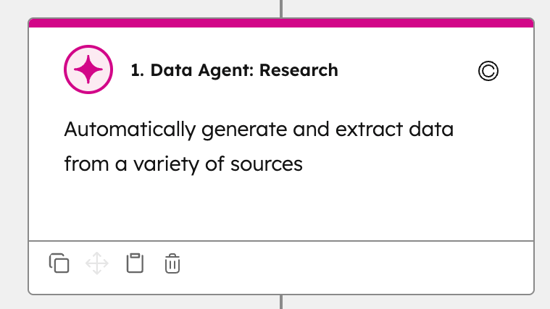Most teams aren’t short on data—they’re short on answers. HubSpot’s Breeze Data Agent changes that by turning your CRM into a proactive intelligence layer. Ask real business questions, surface patterns across contacts, deals, and content, and route insights straight into the workflows that drive growth. This top-of-funnel guide explains what Breeze Data Agent is, why it matters, and how to pilot it without disrupting your stack.
-Oct-22-2025-08-19-35-7670-AM.png?width=2000&height=1128&name=Velocity%20Blog%20Featured%20Images%20(1)-Oct-22-2025-08-19-35-7670-AM.png)
Covered in this article
What Is HubSpot’s Breeze Data Agent?
Why It Matters for Marketing, Sales & RevOps
How to Evaluate & Get Started (Fast)
Limitations & What to Watch
Use-Case Walkthrough: From Question to Revenue Signal
How Velocity Helps You Implement & Scale
FAQs
What Is HubSpot’s Breeze Data Agent?
Breeze Data Agent is part of HubSpot’s Breeze AI suite—purpose-built agents that sit natively inside your HubSpot portal to analyse CRM records, conversations, and content. Instead of static dashboards, you get an AI agent that answers questions like “Which accounts look ready for outreach this week?” or “Which content assets are most correlated with pipeline creation?”

Because it’s native to HubSpot, the Data Agent reads your objects (contacts, companies, deals, tickets), understands relationships, and returns actionable recommendations you can turn into lists, tasks, or automations. Think of it as an always-on analyst embedded in your go-to-market system—one that aligns perfectly with the momentum shown at INBOUND ‘25’s AI-powered growth announcements.
Why It Matters for Marketing, Sales & RevOps
For most businesses, the challenge isn’t gathering data—it’s turning it into something actionable. Marketing teams drown in engagement metrics without clear insight into what’s driving intent. Sales teams spend hours sifting through CRM records trying to find deals worth pursuing. RevOps leaders struggle to connect it all into one clean, measurable picture. That’s where HubSpot’s Breeze Data Agent steps in.
By embedding AI directly inside HubSpot’s CRM, it gives every team a shared source of truth—one that’s not just accurate but intelligent. Marketing sees which campaigns influence real pipeline, sales gets signals on which accounts are heating up, and RevOps gains clarity on where to focus resources. Breeze Data Agent transforms the CRM from a place where data is stored into a system where decisions are made, accelerating collaboration, forecasting, and growth across the entire revenue engine.
- Marketing: Identify segments with rising intent signals, map content to outcomes, and spot channel waste. For property and location-based plays, see how teams are unlocking demand signals with AI.
- Sales: Surface warm accounts, risk on open deals, and next-best actions—cutting the research time that slows velocity. Explore a real-world lift in our Agicap case study.
- RevOps: Clean data faster, enrich systematically, and route insights into workflows—tying activity to revenue. It’s the same agentic backbone that’s transforming day-to-day workflows with autonomous automation.
Strategically, Data Agent helps you move beyond the linear funnel to the continuous, feedback-driven motions modern growth demands—what we call Loop Marketing.

How to Evaluate & Get Started (Fast)
Getting started with HubSpot’s Breeze Data Agent doesn’t require a data science background or a complex implementation plan—it’s built for real business users. The goal isn’t to replace your analysts; it’s to empower your teams to ask smarter questions and act faster. Evaluating and setting up the agent starts with defining what insights you actually want from your CRM—whether that’s identifying the hottest leads, cleaning up duplicate records, or uncovering patterns in closed-won deals.
Because the Breeze Data Agent lives natively inside HubSpot, you can start small and scale easily. Think of it as testing intelligence in motion: you connect your CRM, set the scope of your query, validate the output, and iterate. Within days, your teams can move from manual data pulls to automated insight generation—fueling marketing precision, sales velocity, and operational clarity without overhauling your existing systems.
1) Define a business question
Start narrow. Examples: “Which ICP accounts showed new engagement in the last 14 days?” or “Which webinars correlate with opportunities over $50k?” A crisp question makes evaluation measurable.
2) Check data readiness
Confirm your CRM hygiene: lifecycle stages, lead source, last activity, industry, ARR/budget fields, and owner assignments. Minimal cleanup upfront = clearer answers later.
3) Connect the agent and set scope
Enable the Data Agent in your HubSpot portal and grant it access to the objects and properties required for your question. Use a sandbox if you want to test impact safely.
4) Validate outputs
Review the agent’s answers with a cross-functional squad (marketing, sales, RevOps). Spot-check records the agent recommends; confirm that the rationale matches real-world context.
5) Route into action
Turn the agent’s recommendations into lists, tasks, sequences, or nurture tracks. The power isn’t the answer—it’s the workflow that happens next.
6) Instrument learning loops
Dashboards should show: agent suggestions → follow-up actions → pipeline created → revenue won. Keep a weekly retro to promote high-signal prompts and retire noisy ones.
*Limitations & What to Watch
Like any insight engine, the quality of its output depends on the quality of the data it analyses. If your CRM is cluttered with outdated contacts, missing fields, or inconsistent properties, the agent’s recommendations will reflect that. It’s a powerful accelerator, but it doesn’t replace strong data governance or human judgment.
Before rolling it out across departments, businesses should understand how it handles enrichment accuracy, privacy, and access permissions. Some features may require additional credits or be available only on higher HubSpot tiers, so scoping your use case upfront is essential. The most successful teams treat Breeze Data Agent as a partner—not a black box—balancing automation with review, testing, and refinement to ensure every insight translates into real, measurable action.
- Data quality in, insight out: If core fields are blank or inconsistent, expect noise. Prioritise standardisation and enrichment first.
- Coverage variance: Some datasets (titles, firmographics) may be incomplete depending on market—keep human review in the loop.
- Governance: Decide which teams can publish agent-driven lists or automations, and require change notes for transparency.
- Cost & credits: Advanced features may consume credits—model ROI with a short pilot before scaling.
*Please note that at the time of writing this article, Breeze Data Agent is still in beta testing. We are excited to test the final product and report on it.
Use-Case Walkthrough: From Question to Revenue Signal
When it comes to AI-powered insights, theory only gets you so far—what truly matters is how it works in practice. The Breeze Data Agent is designed to turn everyday business questions into revenue-driving actions, and seeing it in motion makes its value tangible. This section walks through a real-world example that mirrors how marketing, sales, and RevOps teams can use the agent to uncover high-intent opportunities, act on them instantly, and measure the impact across the funnel.
By following this process, you’ll see how a single prompt—like identifying accounts showing renewed engagement—can trigger a cascade of data analysis, lead prioritisation, automated outreach, and measurable ROI. It’s where abstract AI promise meets practical business growth, showing exactly how to move from question to revenue signal.
Scenario: A B2B SaaS team suspects mid-market healthcare accounts are heating up but lacks proof.
- Ask: “Which healthcare companies with 100–500 employees saw increases in web or email engagement in the last 21 days and are not yet in pipeline?”
- Agent does the work: It scans company & contact events, clusters behaviour, and returns a ranked list with reasons (recency, frequency, content type).
- Act: RevOps converts results to a dynamic list; SDRs auto-create tasks and sequences; Marketing launches a 3-touch nurture aligned to the content theme driving engagement.
- Measure: Dashboard tracks sequence replies, meeting set rate, and opp creation vs. control. Insights feed back into content planning and territory focus.
The same pattern applies beyond SaaS—think alumni engagement for higher education (see how top universities scale outreach) or intent clustering for regional campaigns.

How Velocity Helps You Implement & Scale
Velocity operationalises Breeze Data Agent so it doesn’t become “yet another AI tool.” We align your questions with revenue levers, clean and standardise core fields, and wire agent outputs into sales and marketing motions. Then we build dashboards that prove what’s working—and retire what isn’t—so your AI program compounds value month after month.
- Readiness audit: Data model, lifecycle definitions, and property hygiene.
- Pilot design: One question, one segment, four-week ROI readout.
- Workflow wiring: Lists, sequences, nurtures, and task queues tied to agent insights.
- Governance: Roles, permissions, and change logs for responsible scaling.
Ready to turn your CRM into an insight engine? Talk to Velocity about HubSpot CRM implementation & optimisation and pilot Breeze Data Agent with a clear success metric.
FAQs
1) Do we need HubSpot Enterprise to use Data Agent?
You’ll run it inside your HubSpot portal with appropriate access and credits. We’ll help you select the right tier based on volume, objects, and intended automations.
2) What kind of questions can it answer?
Think business questions grounded in CRM data: rising-intent accounts, content influencing pipeline, at-risk deals, churn signals, and segment opportunities.
3) How long does a pilot take?
Most teams can run a focused 4-week pilot: readiness (week 1), prompt & scope (week 2), action & instrumentation (week 3), results readout (week 4).
4) Will this replace BI?
No—it complements BI by answering operational questions quickly and routing actions. Strategic reporting still lives in your analytics suite.
5) What’s the best way to prove ROI?
Pick a narrow segment, track agent-driven actions vs. control, and measure meetings set, pipeline created, and win rate lift within a defined window.
6) How does Breeze Data Agent differ from HubSpot’s standard reporting tools?
Traditional dashboards summarise what’s already happened. Breeze Data Agent goes further—it analyses live CRM data, spots correlations, and proactively delivers insights in natural language, helping teams act before opportunities slip away.
7) Can Breeze Data Agent integrate with data from non-HubSpot sources?
Yes, it can connect through HubSpot’s integrations and APIs to pull data from systems like Salesforce, Google Sheets, and other connected apps. The richer your data ecosystem, the more accurate and contextualised your insights become.
8) How secure is the data processed by Breeze Data Agent?
HubSpot applies the same enterprise-grade encryption and compliance standards (SOC 2, GDPR, ISO 27001) used across its CRM. Data never leaves your HubSpot environment and is processed securely through their AI infrastructure.
9) What kind of teams benefit most from using the Data Agent?
It’s built for RevOps-driven organisations—where marketing, sales, and service share one CRM. Teams that rely heavily on data for forecasting, lead scoring, or campaign optimisation will see the fastest impact.
10) Can I train or customise the Breeze Data Agent for my business?
Absolutely. You can tune prompts, restrict data scope, and feed in contextual knowledge (like custom properties or deal stages) so the agent delivers insights unique to your organisation’s goals and data model.





